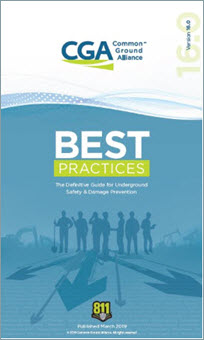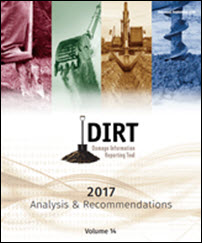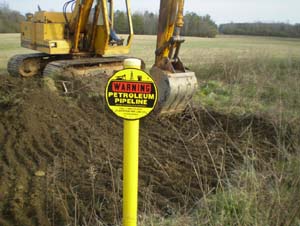
NEW!! PHMSA has created a heat map to display pipeline accidents and incidents caused by excavation damage. To view, click here. PHMSA's final rule on excavation enforcement establishes a process for enforcement of minimum Federal damage prevention standards in States where damage prevention law enforcement is inadequate. |
Excavation damage continues to be a leading cause of pipeline incidents.
Pipeline incidents caused by excavation damage can result in fatalities and injuries, as well as significant costs, property damages, environmental damages, and unintentional fire or explosions.
State-specific Damage Prevention Information
PHMSA has gathered and reports excavation damage related information for each state. Go to the index of State Pages on this site to access a wealth of information for each state. Follow the state “Damage Prevention Information” links to access a variety of data and information related to damage prevention for each state.
Additionally, PHMSA’s Pipeline Data Mart (PDM) allows you to query state-specific pipeline excavation damage data.
Summary of State Damage Prevention Laws
| Pipeline Accidents and Incidents |
|---|
PHMSA has created a heat map to display pipeline accidents and incidents caused by excavation damage. To view, click here. |
| PHMSA has collected pipeline incident reports since 1970. The reporting regulations and incident report formats have changed several times over the years. PHMSA has merged the various report formats to create pipeline incident trend lines going back 20 years. Follow this link. |
PHMSA developed and maintains a summary of state damage prevention laws. PHMSA’s summary reflects state damage prevention law requirements categorized relative to: Excavator Requirements; Operator Response; and, One Call, Enforcement, and Reporting. You may view all the summary information for individual states by visiting the Damage Prevention Information pages. You may also download the entire summary spreadsheet for all states (Microsoft Excel format).
NOTICE: The summary information pertaining to state excavation damage prevention laws and regulations contained in this spreadsheet and on this website is provided as a public service and is intended for general information purposes only. PHMSA will strive to keep the information up to date and correct, however we make no representations or warranties of any kind, express or implied, about the completeness, accuracy, reliability, suitability or availability with respect to the website or the information, products, services, or related graphics contained on the website for any purpose. PHMSA expressly disclaims liability for errors and omissions in the contents of this website. If any information you are using requires an absolute assurance for any reason as to its accuracy, please see the official state laws, policies, and/or procedures
History of Damage Prevention
In October 2014 PHMSA submitted to Congress a report entitled, "A Study on the Impact of Excavation Damage on Pipeline Safety”. That report was prepared in response to a requirement in the Pipeline Safety, Regulatory Certainty, and Job Creation Act of 2011 (Public Law 112–90, January 3, 2012) that directed the Secretary of Transportation to conduct a study on the impact of excavation damage on pipeline safety, including the impact of removing all exemptions for mechanized equipment from State one-call laws.
In July 2015 PHMSA announced the issuance of a Final Rule to revise Federal pipeline safety regulations to establish the process for evaluating State excavation damage prevention law enforcement programs and enforcing minimum Federal damage prevention standards in States where damage prevention law enforcement is deemed inadequate or does not exist. The final rule amended the Federal pipeline safety regulations to establish:
- Criteria and procedures PHMSA will use to determine the adequacy of State pipeline excavation damage prevention law enforcement programs;
- The administrative process PHMSA will use in determining the adequacy of State excavation damage prevention law enforcement programs;
- The Federal requirements PHMSA will enforce in States with inadequate excavation damage prevention law enforcement programs; and
- The adjudication process for administrative enforcement proceedings against excavators where Federal authority is exercised.
In August 2017 PHMSA submitted to Congress the report titled "A Study on Improving Damage Prevention Technology." Also see Appendix A to the Report, regarding PHMSA-Supported Research and Development Projects and its Competitive Academic Agreement Program. This study looked at improving existing damage prevention programs through technological improvements in location, mapping, excavation, and communications practices to prevent excavation damage to a pipe or its coating, including considerations of technical, operational, and economic feasibility and existing damage prevention programs.
| Preventing Damage to Pipelines in Marine Environments |
|---|
In response to marine pipeline incidents, the Council for Dredging and Marine Construction Safety (CDMCS) Pipeline Task Force was formed. For more information on the members and activities of this task force, click here. |
State Damage Prevention Program Characterizations
The nine elements of effective damage prevention programs were cited by Congress in the Pipeline Inspection, Protection, Enforcement and Safety (PIPES) Act of 2006. Since 2009 PHMSA has lead assessments of state damage prevention programs to characterize the extent to which they incorporate the nine elements.
These assessments enable PHMSA, working with state pipeline safety program managers and one-call centers, to gain a better understanding of the successes and challenges existing in state damage prevention programs, where additional improvement is needed, and where PHMSA should focus its assistance.
PHMSA conducted state damage prevention program characterization (SDPPC) assessments in 2009, 2011, and again in 2014. The updated characterizations have shown that States have taken steps to strengthen their programs, but there remain areas where state programs could still be improved relative to the nine elements. See more discussion of the SDPPC initiative.
Damage Prevention and the Nine Elements
Drawing on the definition of effective damage prevention programs found in the PIPES Act of 2006, PHMSA developed guidance to assist stakeholders by examining the nine elements specified in the PIPES Act and offering suggestions for implementing them at the state level. The guidance, “Strengthening State Damage Prevention Programs”, can support States to improve their programs by incorporating the nine elements and by identifying and implementing positive changes in processes, procedures, technologies and damage prevention laws.
PHMSA's Community Liaisons (formerly Community Assistance and Technical Services)
PHMSA’s Community Liaisons serve as "trusted" and "credible" stewards of public safety and environmental protection by raising awareness and influencing change to continuously improve pipeline safety. If you need assistance with any of the following pipeline safety related matters, please contact a PHMSA Community Liaison today:
- Pipeline safety policy/programs (damage prevention, public awareness, emergency response, PIPA, etc.)
- Pipeline stakeholder engagement and outreach
- Pipeline technical services and support (public inquiries, whistleblowers, post incident/accident communications, siting and permit initiatives)
- Questions about pipeline safety in your community

Grants to States and Communities
PHMSA provides grant opportunities intended to help improve state damage prevention programs. Visit State Damage Prevention (SDP) Program Grant for information on the program and how to apply.
The Safe Digging Process
The primary tool for avoiding damages to underground facilities is timely communication between excavators and the owners of the facilities. It is important to Call Before You Dig and Dig Safely by always following safe digging practices. One-call centers facilitate this communication process by enabling an excavator to place just one call, prior to digging, to request that all underground facilities in the area of a planned excavation be located and marked.
811
Call 811, toll free, to reach the one-call center that will notify the companies that may operate underground utilities in the area you plan to dig. Those companies can then determine and mark the exact location of their utilities so that you can avoid hitting those utilities when you excavate. Visit Call811.com for more information.
Hitting underground utilities when you are digging can cause injuries, even deaths, environmental damage and loss of critical infrastructure and services. If you don’t make the call, you could be liable for damage costs and repairs, as well as subject to potential penalties. It is important to call the one-call center before you dig – anytime of the year and no matter who you are or how big or small your project is. The call is free so Call 811 Before You Dig.
Cross Bore Risk Reduction
Cross bores can have a significant impact on utility system integrity. To mitigate the occurance of a cross bore, refer to Leading Practices for Cross Bore Risk Reduction as published by the Cross Bore Safety Association.

Common Ground Alliance (CGA)
The CGA is a member-driven nonprofit organization committed to saving lives and preventing damage to underground infrastructure by promoting effective damage prevention practices.
Best Practices
In 1999, PHMSA published the Common Ground Study of One-Call Systems and Damage Prevention Best Practices. The Study identified and validated existing Best Practices to prevent damages to underground facilities. The Best Practices were intended to be shared among stakeholders involved with and dependent upon the safe and reliable operation, maintenance, construction, and protection of underground facilities. Stakeholders are encouraged to examine and evaluate the Best Practices for possible incorporation into state, local, and private stakeholder underground facility damage prevention programs.
In 2000, the Common Ground Alliance (CGA) was formed to further the work completed during the Common Ground Study. Since the CGA’s establishment, the Best Practices have been regarded and utilized as an important resource for underground damage prevention. The Best Practices are designed to improve worker safety, protect vital underground infrastructure, and ensure public safety during excavation activities conducted near existing underground facilities.
Now widely recognized as the “Best Practices”, they are continuously reviewed by a CGA committee, and changes to existing Best Practices and new Best Practices are agreed on by consensus. The CGA releases a new edition of the Best Practices every spring with updates that reflect changes in damage prevention, including those caused by the always-evolving technologies that are at the core of progress in the industry.

Damage Information Reporting Tool (DIRT)
The CGA’s Data Reporting & Evaluation program collects and analyzes critical information regarding damage prevention and produces targeted recommendations to stakeholders about how to best protect buried facilities. To facilitate damage information data collection, the CGA launched the Damage Information Reporting Tool (DIRT) to enable stakeholders to submit underground damage and near-miss data reports through a completely secure, private web application. Using this information, the CGA publishes an annual report (the DIRT Report) that includes data analysis, conclusions, and recommendations to identify areas where damage prevention programs are most effective and where enhancements are needed.
The CGA works cooperatively, fostering a sense of shared responsibility to enhance safety and protect underground facilities by:
- Identifying and disseminating the stakeholder best practices;
- Developing and conducting public awareness and education programs;
- Sharing and disseminating damage prevention tools and technology; and
- Serving as a resource for damage and one call center data collection, analysis, and dissemination.

One-Call Technology Pilot Project
We partnered with damage prevention stakeholders in Virginia to use existing GPS technology to enhance the quality of communication among excavators and owners of underground facilities. The Phase I Report includes guidance on how other States could incorporate GPS technology in their One-Call Center communications.
Pipeline Operator Public Awareness Programs
Federal pipeline safety regulations require pipeline operators to conduct continuing public awareness programs to provide pipeline safety information to stakeholders.
Comprehensive Report on Pipeline Mechanical Damage
This work consolidates a collective knowledge on the many aspects of mechanical damage to pipelines. The report has three main parts addressing damage prevention, detection and characterization from primarily an onshore, transmission pipeline perspective. However, the prevention portion of this report is significant for gas distribution systems. Pipeline Mechanical Damage. [This is a large file (approx. 40 MB)].
Research & Development (R&D)
The importance of damage prevention is recognized within our R&D program by establishing a distinct category for projects geared toward damage prevention. Damage Prevention R&D Projects are designed to provide stakeholders with improved tools to reduce the risk of excavation damage.
PHMSA Advisory Bulletins
We have consistently taken a non-regulatory approach to pipeline damage prevention. However, we have used Advisory Bulletins to emphasize important actions pipeline operators can take to protect their pipelines. In May 2002, we urged pipeline operators to follow the CGA Best Practices for damage prevention. In January 2006, we described preventable accidents caused by construction-related damage and called on operators to ensure they use qualified personnel to perform critical damage prevention tasks. In November 2006, we emphasized the importance of following damage prevention best practices, especially for marking the location of underground pipelines prior to excavation.
